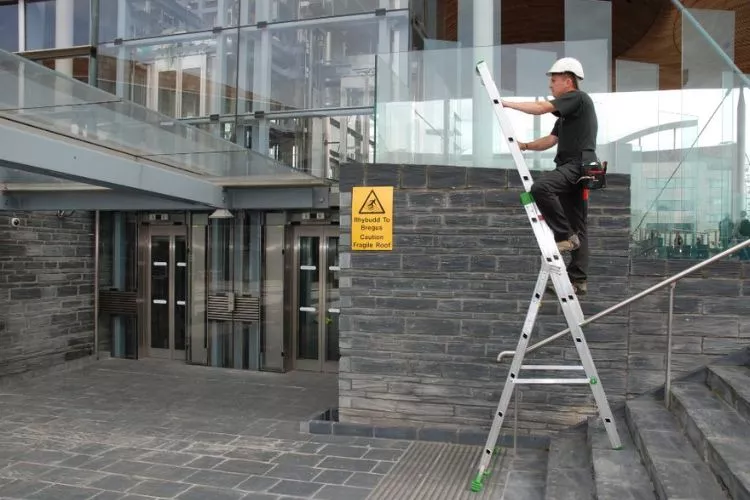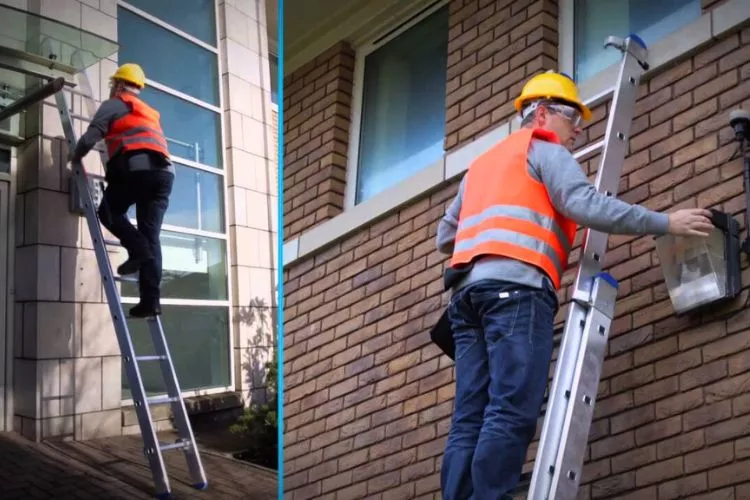Combination Ladder is a fusion of flexibility, convenience, and safety, this multi-functional tool has revolutionized working at various heights.
But what exactly is a Combination Ladder, and why is it gaining increased prominence among professionals and DIY enthusiasts alike?
In this article, we break down the distinctive features of a Combination Ladder, its different configurations and ideal applications.

We aim to give you a comprehensive understanding of this versatile device, showing how it is much more than just a simple means to reach high places.
Let’s elevate your knowledge and explore the art of efficient climbing.
What Is A Combination Ladder?
A Combination Ladder is a versatile, adjustable ladder that can be used in various configurations to adapt to different working conditions and tasks.
This multi-purpose tool can function as a straight ladder, step ladder, trestle, extension ladder, and often, a stairway ladder.
Its design allows it to fold and extend, providing different height options according to the task at hand.
Manufactured with safety features like anti-slip rungs and sturdy locking mechanisms, it allows for secure climbing. Its adjustability facilitates usage on uneven grounds, making it an especially practical tool in difficult environments.
Thanks to its adaptable nature, the Combination Ladder offers increased flexibility and convenience, which makes it a preferred choice among professionals like handymen and painters, as well as DIY enthusiasts undertaking various home improvement tasks.
Despite its multiple functions, it is usually compact and portable, enhancing its practical appeal.
What is a combination ladder used for?
A Combination Ladder is primarily designed to offer increased versatility and safety across a wide range of tasks that require working at heights. Due to its adjustable nature and multiple configurations, it serves many functions, depending on the user’s needs:

- As a Step Ladder: This is the most basic use of a combination ladder. In this configuration, it provides a steady, freestanding platform, ideal for indoor and outdoor tasks like painting, decorating, or changing ceiling lights.
- As an Extension Ladder: The ladder can be extended to reach higher places. This is perfect for roof work, tree pruning, or house exterior cleaning.
- As a Stairway Ladder: Unique to combination ladders, they can be adjusted to sit securely on staircases, enabling safe access for tasks like stairwell painting or installations.
- As a Trestle: The combination ladder can also serve as a support base for scaffolding, improving the safety and efficiency of construction and renovation work.
- As a Leaning Ladder: When one side is fully extended and the other left short, it can lean against walls or other supports, offering secure access to hard-to-reach places.
- For Uneven Grounds: The legs of the ladder can be adjusted individually, making it an excellent tool for working on uneven surfaces like hillsides or steps.
The sturdy construction and flexibility of the combination ladder make it a popular choice for a wide array of tasks in construction, home improvement, building maintenance, cleaning, and even emergency rescue operations. Its use spans multiple sectors, from residential to industrial applications.
Combination ladder requirements
When using a combination ladder, it’s crucial to follow safety codes and standards to ensure optimal security. Here are some important requirements and considerations:
- Material: Combination ladders can be made of various materials including aluminum, fiberglass, and steel. The choice depends on your needs. For example, fiberglass ladders are non-conductive and are safer around electricity, aluminum ladders are lightweight for easy transportation, and steel ladders offer high durability.
- Load Capacity: Every ladder has a maximum load capacity, which includes the weight of the user along with any tools or materials being used. Often classified as Duty ratings, they range from Type III (200 lbs) for light-duty household applications, up to Type IAA (375 lbs) for heavy-duty industrial use.
- Adjustable Mechanism: A combination ladder should have a simple and reliable adjustment mechanism, often involves locking hinges and rung locks, that keeps all configurations sturdy and stable.
- Safety Features: Anti-slip feet, wide rungs, and safety locks are crucial. Some models may also include additional features like level indicators or handrails.
- Standards Compliance: Ladders should comply with the safety standards of bodies such as the Occupational Safety and Health Administration (OSHA) and the American National Standards Institute (ANSI) in the U.S., or relevant bodies in other countries.
- Maintenance and Inspection: Regular inspection for defects like cracks, corrosion, or loose components is crucial for safe use. Always follow manufacturer’s instructions for maintenance.
- Storage and Handling: Proper storage in a protected, dry place extends the lifespan of a ladder. With their adjustable designs, many combination ladders can be compacted for easy transport and storage.
- Training and Usage: Incorrect usage can lead to accidents. Thus, appropriate training is important, and instructions provided by the manufacturer should always be followed.
Remember that using a ladder that meets all the necessary requirements ensures not just a high level of safety, but also improves productivity, reducing the need to constantly swap between different types of ladders for different tasks.
Combination ladder price
The price of a combination ladder can vary greatly depending on several factors, including the material, size, brand, features, and load capacity. Here’s a breakdown of these factors to help you understand what you might expect to spend on a combination ladder:

- Material: Aluminum combination ladders are usually more affordable and lightweight, making them a popular choice. On the other hand, fiberglass ladders are pricier due to their non-conductive property, which makes them safer for electrical work.
- Size: Larger ladders, with more steps, or those that can reach higher elevations, are generally more expensive compared to their smaller counterparts.
- Brand: Well-established brands that are recognized for their quality and durability often come at a premium.
- Features: Ladders with additional safety features, such as non-slip rungs or feet, telescoping design, wider steps, or easy-lock mechanisms may also have a higher price tag.
- Load Capacity: Ladders with a higher weight capacity (Type I, IA, and IAA ladders) usually cost more as they are designed for industrial or heavy-duty use.
In terms of numbers, to give a rough estimation, an entry-level aluminum combination ladder can start from around $100, while top-of-the-range fiberglass models with advanced features can reach up to $400 or more.
It’s essential to base your purchase not solely on price but on what the ladder can provide in terms of safety, convenience, durability, and versatility. Consider your specific needs and the kind of tasks you’ll be doing most often when choosing a combination ladder.
Frequently Asked Questions (FAQs)
What is a combination ladder in a ship?
A combination ladder in a ship refers to a safety device used for boarding and disembarking from ships, particularly by pilots. It consists of the ship’s side accommodation ladder and a pilot ladder joined together to create a secure and steady passage to and from the ship. Compliant with SOLAS (International Convention for the Safety of Life at Sea) regulations, these ladders ensure smooth and safe transfer, enduring adverse sea conditions.
What is the maximum angle for a combination ladder?
The angle of the combination ladder depends on its particular configuration. As a free-standing stepladder, it should ideally be set at an angle of approximately 75 degrees to the ground for optimal stability. When used as an extension ladder against a surface, the safe angle is typically 75.5 degrees, in accordance with the 4-to-1 rule, where for every four units of height, the ladder base should be one unit away from the surface it’s leaning against.
What is the length of a combination ladder?
The length of a combination ladder can greatly vary depending on the model, ranging from 10 to 20 feet or more when fully extended. However, because it’s adjustable, it can be shortened or lengthened according to the task at hand. This flexibility allows the ladder to provide access to varying heights, making it extremely versatile. Always refer to your specific ladder’s specifications to understand its minimum and maximum length thresholds.
Conclusion:
To wrap up, a combination ladder is a versatile, multi-functional tool that has transformed how we reach higher places. With its ability to act as a step ladder, extension ladder, trestle, and even a stairway ladder, it provides flexible solutions for various tasks at different heights.
The safety features incorporated, its adaptability for uneven surfaces, and its compact, portable design make it a preferred choice among professionals and DIY enthusiasts alike.
Despite its distinct configurations, the key to safely using a combination ladder lies in understanding its proper use and maintenance, ensuring the right ladder for the task is always within reach.


